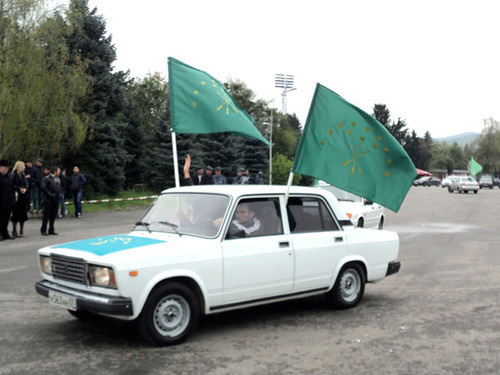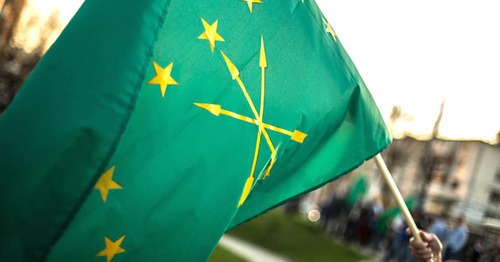April 25, 2017, 11:17
Circassian Flag Day
April 25 Circassians around the world celebrate the Circassian flag Day. In Karachay-Cherkessia, Adygea and Kabardino-Balkaria, the Circassian public also organizes horse crossings, car races, dance games, sports and other celebrations. The ” Caucasian Knot ” has gathered information about the symbolism of the Adyghe flag, the history of its occurrence and some traditions of the celebration of the Circassian flag day.
Symbols of the Circassian flag
The Circassian flag is one of the main symbols of the Adyghe (Circassian) people . It is a green rectangular field, which shows three crossed golden arrows and 12 golden stars.
The symbolism of the flag – stars, arrows, a combination of colors – is interpreted differently.
The most common interpretation of 12 stars is that they symbolize the 12 main Circassian tribes (subethnoses): Abadzekhs , besleleny, Bjedugs, Zhanei, Kabardei ( Kabardins ), Mamhegi, Mahoshi, Natukhai, Temirga, Ubykh, Khatukai, Shapsugi .
According to one version, three crossed arrows symbolize the three main princely families.
Another version says that three crossed arrows are a symbol of unity and peace . In peacetime, the Circassians, who belonged to the elite military class, usually carried three arrows in a quiver: arrows pointing upward meant peace, and crossed arrows – unity. They go back to the symbolism associated with the hero of the Nart epic Tlepsh, the patron saint of blacksmithing.
The color symbolism of the flag is also ambiguous. Some scholars believe that green is the color of Islam 1 . But green (like blue, and white, and black, and red in the Circassian culture) had rich symbolic meanings as the color of spring and rebirth in pre-Islamic times.
Flag history
Various versions are expressed about the origin of the Circassian flag, although all of them attribute the appearance of this symbol to the 1830s.
According to one version, the Circassian flag was made in the UK and brought to Western Circassia in 1834 by Scottish diplomat and writer, Secretary of the British Embassy in Istanbul, David Urquhart as part of his mission to support the Highlanders and counter the authorities of the Russian Empire 2 . To this end, in 1836, the British schooner “Vixen” with a contraband cargo of weapons was sent to Sujuk-kale (modern Novorossiysk). The ship was arrested by the Russian military brig “Ajax”, and the team was sent to Istanbul. This provocation allowed conservatives in the British parliament to raise the question of the legality of the presence of Circassia as part of Russia 3 .
According to the version set forth in the book of the English traveler Edmund Spencer “Journey to Circassia, Crimea – Tatarstan …”, which was published in London in 1838, the flag was made by a high-profile Circassian in Turkey and brought to her homeland, to Circassia.
There is a version that combines the two above: the sketch of the flag was proposed by David Urquhart, and the flag itself was made in Turkey by the Circassian princess 4 .
There is a version cited to the correspondent of the “Caucasian Knot” by the journalist of the Circass Hack newspaper, Dina Kushtova, according to which the flag was proposed by the Circassian prince Zan Sefer-bei . It is also believed that this flag was first delivered to the Sheregesh Valley region (modern Sochi) by British agent James S. Bell in 1837-1840.
After the Caucasian war, the Circassian flag was banned. More than a century after the end of the war, the image of the flag of the Circassians (Adygs) was considered lost until it was discovered in the book of the English traveler Edmund Spencer “Journey to Circassia, Crimea – Tatarstan …”.
In the late 80s of the XX century, when the Soviet Union took the path of democratization, for the first time in the Caucasus, the Circassian flag was restored. It was first introduced to the general public at the constituent congress of Adyghe Khase of the Republic of Adygea 5 .
After the Adygea Autonomous Region left the Krasnodar Territory and the proclamation of the independent subject of the Federation – the Republic of Adygea, in March 1992 it was approved by the Supreme Council of the republic as its state flag.
Circassian Flag Day
 According to tradition, the celebration of the flag day begins with a horse transition or motor rally and ends with Adyghe Dzhegu (Circassian dance game).
According to tradition, the celebration of the flag day begins with a horse transition or motor rally and ends with Adyghe Dzhegu (Circassian dance game).
Circassian flag day was celebrated for the first time on April 25, 2010, when its 180th anniversary was celebrated. As one of the organizers of the holiday, the assistant to the member of the Federation Council, Asfar Kuek, said that the date of April 25 was chosen arbitrarily , “I wanted to spend the holiday in the spring, because it is this time of the year that symbolizes birth.”
On the evening of February 18, 2011, as a result of an attack on a minibus with tourists in the village of Zayukovo, Baksan district of the KBR , three people died – tourists from Moscow. Since February 20, 2011, in the three districts of Kabardino-Balkaria , a counter-terrorism operation regime was introduced . Therefore, Circassian Flag Day was not widely celebrated in the CBD, although there was no ban on the celebration .
April 25, 2011 Circassian Flag Day was widely celebrated in Adygea and Karachay-Cherkessia .
In 2012, as part of the celebration of the Circassian Flag Day in three republics of the North Caucasus – Adygea, Karachay-Cherkessia and Kabardino-Balkaria – the Circassian public organized horse crossings, motor rallies, Circassian dance games and sports.
In Karachay-Cherkessia, festive events were suppressed by the police. At 10.00, about 15 representatives of the Circassian youth began an equestrian transition from the village of Zhako, Khabez district of Karachay-Cherkessia to Cherkessk. On the way, riders began to be stopped by police officers. In the city of Cherkessk they were forbidden to ride on horses. The riders entered the city through the forest, but the police did not allow the ceremony to honor and pass the flag to the participants of the celebration . The flag was nevertheless handed over to the participants of the holiday, and the traditional Circassian event “Adyghe Dzhegu” began 2 hours late. Festive dances were organized, without any incident.
In Georgia, the holiday was organized by the Circassian Cultural Center and was held at the National Library
. The event was attended by employees of the center, scientists, the public of Georgia, students.
In 2013, it was planned to hold an Adyghe Dzhegu rally coordinated with the authorities and the Circassian dance game in Maykop . According to the Ministry of Internal Affairs in Adygea, in total about 1700 residents of the republic took part in the events . The rally was attended by about 600 residents. Festive events were also held in Kabardino-Balkaria , where a rally was held with the participation of several dozen cars – and Karachay-Cherkessia , in the capital of which about a hundred people took part in the dance party “Adyghe Dzhegu.”
In 2014, more than 550 people took part in events in honor of the Circassian flag in Karachay-Cherkessia . Events were held in the village of Khabez of the Khabez district and in Cherkessk. Also, festive events were held in Adygea, Kabardino-Balkaria, Krasnodar Territory .
On April 25, 2015, more than 100 cars participated in the rally in honor of Circassian Flag Day in Kabardino-Balkaria . The rally runs along the route Nalchik, Chegem 1, Dygulibguey, Baksan, Altud, Prokhladny, Maysky, Julat, Arik, Terek, Aleksandrovskaya, Argudan, Old Cherek, Nizhny Cherek, Kakhun, Nartkala, Urvan, Nalchik.
However, the “Adyghe Khase” of Kabardino-Balkaria and the Coordinating Council of Adyghe public organizations refused to participate in the rally in honor of Circassian Flag Day in Nalchik, because the authorities demanded a list of participants in the rally .
Also , an exhibition of works by Circassian artists was held at Tbilisi State University , as well as a presentation of the book “Circassia – My Pain.”
In 2016, the events on the Circassian Flag Day were held on a larger scale than in previous years: the public movement “Youth Adyghe Hase” and the movement “Adyghe Hase – Circassian Parliament” organized a rally in the Khabez district, a procession in Cherkessk, Adyghe Dzhegu (national dances ) and the ceremony of lighting candles along the contour of the flag.
Circassian flag day is celebrated in more than 50 countries of the world where descendants of Circassian emigrants live.
Notes
- Borisov I.V., Kozina E.N. Heraldry of Russia. M .: “Astrel”, 2006. ↑
- Urquhart, David // Dictionary of National Biography, 1885-1900, Volume 58. London: Smith, Elder & Co. P. 43–45. ↑
- Hopkirk P. The Great Game: On Secret Service in High Asia. Oxford, 2001. P. 158-159. ↑
- Geometry of the Circassian flag // News portal of Adygea and the North Caucasus “Zikhiya.Net”, 11.11.2010. ↑
- Asfar Kuek. The symbol of unity and love for the Fatherland // eLot.ru, 04/12/2011. ↑


